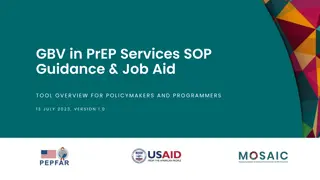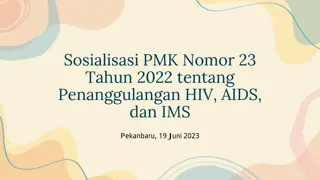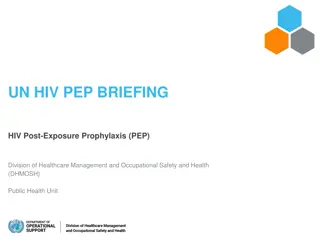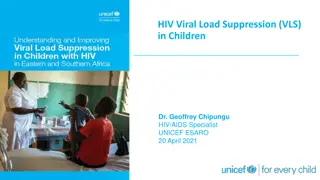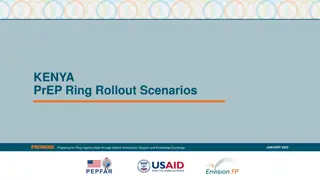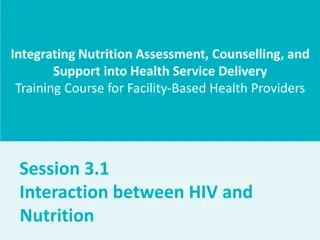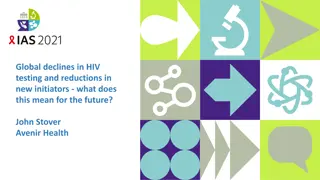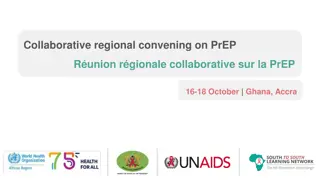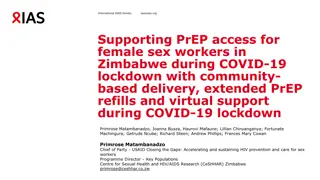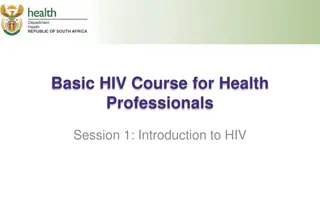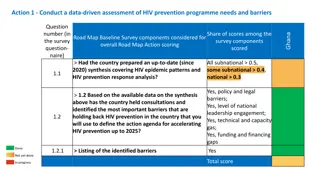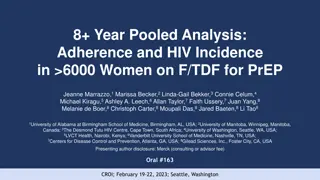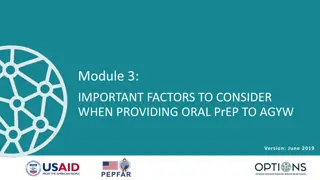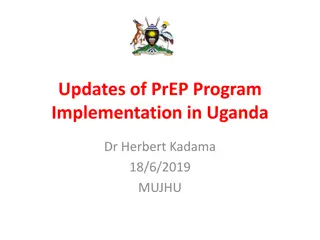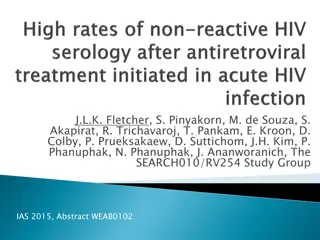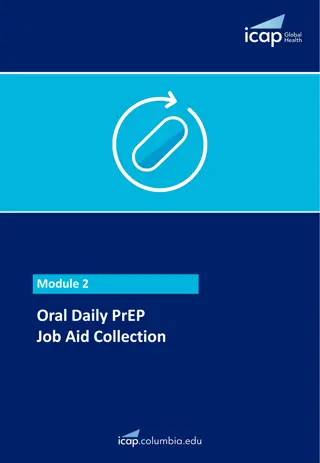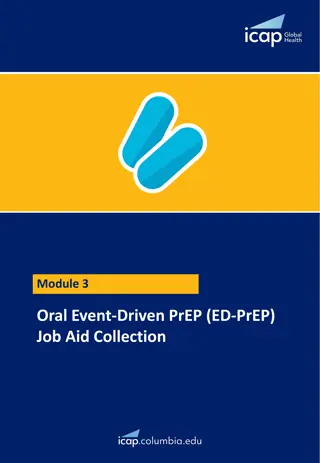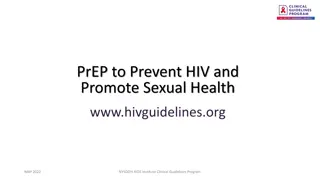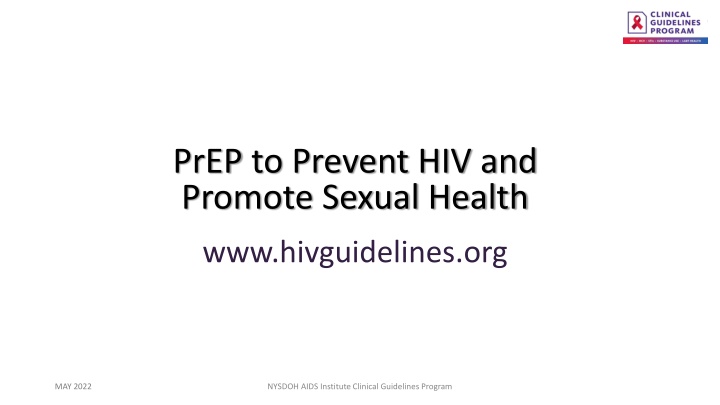
PrEP to Prevent HIV: Clinical Guidelines and Recommendations
This resource outlines the guidelines and recommendations provided by the NYSDOH AIDS Institute Clinical Guidelines Program to increase awareness and access to Pre-Exposure Prophylaxis (PrEP) for individuals at risk of acquiring HIV. It discusses key points, barriers to PrEP, recommendations for PrEP initiation, indications, and contraindications. The goal is to assist clinicians in identifying PrEP candidates and promoting sexual health among high-risk populations.
Download Presentation

Please find below an Image/Link to download the presentation.
The content on the website is provided AS IS for your information and personal use only. It may not be sold, licensed, or shared on other websites without obtaining consent from the author. If you encounter any issues during the download, it is possible that the publisher has removed the file from their server.
You are allowed to download the files provided on this website for personal or commercial use, subject to the condition that they are used lawfully. All files are the property of their respective owners.
The content on the website is provided AS IS for your information and personal use only. It may not be sold, licensed, or shared on other websites without obtaining consent from the author.
E N D
Presentation Transcript
PrEP to Prevent HIV and Promote Sexual Health www.hivguidelines.org MAY 2022 NYSDOH AIDS Institute Clinical Guidelines Program
Purpose of This Guideline Purpose of This Guideline Increase awareness and knowledge of PrEP efficacy among clinicians in New York State. Assist clinicians in identifying candidates for PrEP and increasing awareness of, access to, and uptake of PrEP among individuals in New York State at risk of acquiring HIV through sexual and drug use exposures. Discuss the barriers to PrEP access and encourage clinicians to assist PrEP candidates in reducing or eliminating these barriers. Provide clinicians with the information needed to help a PrEP candidate make the best choice regarding oral versus injectable PrEP and daily versus on-demand PrEP. Provide clinicians with evidence-based recommendations for PrEP initiation, management, monitoring, and discontinuation. MAY 2022 NYSDOH AIDS Institute Clinical Guidelines Program www.hivguidelines.org
Key Point Key Point Same-day initiation of PrEP is the goal whenever possible. MAY 2022 NYSDOH AIDS Institute Clinical Guidelines Program www.hivguidelines.org
Barriers to Barriers to PrEP PrEP Suboptimal awareness or acceptance of PrEP among some individuals at risk for acquiring HIV and their care providers Lack of retention in PrEP care due to individual and structural barriers Stigma, which may keep people who would benefit from PrEP from using it Disparities in access to PrEP among populations at high risk of HIV acquisition, including MSM of color, transgender women, Black women, and people who inject drugs. Emerging evidence suggests that transgender MSM are also at high risk for HIV acquisition and are a population for whom PrEP outreach and access are needed. MAY 2022 NYSDOH AIDS Institute Clinical Guidelines Program www.hivguidelines.org
Recommendations: Recommendations: Indications for Indications for PrEP PrEP Clinicians should recommend PrEP for individuals, including adolescents, who do not have but are at risk of acquiring HIV. (A1) Clinicians should prescribe PrEP for any individual who self-identifies as being at risk of acquiring HIV. (A*) For patients who are completing a course of nPEP and remain at risk for HIV, clinicians should recommend initiation of PrEP immediately after completion of nPEP. (A3) MAY 2022 NYSDOH AIDS Institute Clinical Guidelines Program www.hivguidelines.org
Recommendations: Recommendations: Contraindications to Contraindications to PrEP PrEP Clinicians should not prescribe oral or injectable PrEP for any patient with a documented HIV diagnosis; none of the available PrEP regimens are adequate ART regimens for HIV treatment. (A1) Clinicians should recommend or refer individuals with confirmed HIV for immediate initiation of a fully suppressive ART regimen. (A1) Clinicians should not initiate TDF/FTC as PrEP for any individual with a confirmed CrCl <60 mL/min and should discontinue it in patients with a confirmed CrCl <50 mL/min; in such cases, TDF/FTC as PrEP is contraindicated. (A1) Clinicians should not prescribe TAF/FTC as PrEP for any individual with a confirmed CrCl <30 mL/min; in such cases, TAF/FTC as PrEP is contraindicated. (A1) MAY 2022 NYSDOH AIDS Institute Clinical Guidelines Program www.hivguidelines.org
Candidates for Candidates for PrEP PrEP Offer PrEP to individuals who are candidates for PrEP, including those who: Engage in condomless sex with partners whose HIV status is unknown, who have untreated HIV, or who are being treated for HIV but have unsuppressed virus Are attempting to conceive with a partner with HIV who is not consistently virally suppressed or whose status of suppression is unknown, or wants the further reassurance of HIV prevention via PrEP Are at ongoing risk of HIV acquisition during pregnancy through inconsistent condom use with sex partners who have unsuppressed virus Have multiple or anonymous sex partners or are involved with partners who do Engage in sexual activity at parties and other high-risk venues or have sex partners who do Are involved or have partners who may be involved in transactional sex (i.e., sex for money, drugs, food, or housing), including commercial sex workers and their clients MAY 2022 NYSDOH AIDS Institute Clinical Guidelines Program www.hivguidelines.org
Candidates for Candidates for PrEP PrEP, , continued continued Offer PrEP to individuals who are candidates for PrEP, including those who: Have been diagnosed with at least 1 bacterial STI in the previous 12 months Report recreational use of mood-altering substances during sex, including but not limited to alcohol, methamphetamine, cocaine, ecstasy, and gamma hydroxybutyrate Report injecting substances or having sex partners who inject substances, including illicit drugs, hormones, or silicone Are receiving nPEP and anticipate ongoing risk or have used multiple courses of nPEP Request the protection of PrEP even if their sex partners have an undetectable HIV viral load Self-identify as being at risk without disclosing specific risk behaviors Acknowledge the possibility of or anticipate engaging in risk behaviors in the near future MAY 2022 NYSDOH AIDS Institute Clinical Guidelines Program www.hivguidelines.org
Candidates for Candidates for PrEP PrEP, , continued continued Do not withhold PrEP from eligible candidates who: Are pregnant or planning to conceive Inconsistently use condoms or other risk-reduction methods Engage in substance use Have mental health disorders of any severity Experience intimate partner violence Have unstable housing or limited social support Have recently had an STI Have a partner with HIV who has an undetectable viral load MAY 2022 NYSDOH AIDS Institute Clinical Guidelines Program www.hivguidelines.org
New York State Law: New York State Law: PrEP PrEP for Adolescents for Adolescents New York Consolidated Laws, Public Health Law PBH Article 2305 has long established the legal capacity of minors to consent to treatment and preventive services for STDs. Provisions in Article 2305 require that the Commissioner of Health promulgate a list of STDs. A 2017 amendment to Article 2305 added HIV to the list of STDs, thereby bringing minor capacity to consent to HIV treatment and preventive services on par with other STDs. In addition, under Article 2305, medical or billing records may not be released or made available to the parent or guardian without the minor patient s permission. MAY 2022 NYSDOH AIDS Institute Clinical Guidelines Program www.hivguidelines.org
Selected Good Practice Reminders: Selected Good Practice Reminders: Assessment and Counseling Before Assessment and Counseling Before PrEP PrEP Initiation Initiation Assess the patient s health literacy and ensure that the purpose, benefits, and risks of PrEP are understood. Individualize the decision to initiate PrEP by weighing the benefit of reducing the patient s risk of acquiring HIV against the potential adverse effects of the medication. Make clear that PrEP efficacy is highly dependent on adherence, assess for readiness and willingness to adhere to PrEP and recommended follow-up care, and assess for barriers to adherence. Assess eligibility for injectable PrEP, including the ability to adhere to visits every 2 months for intramuscular injections. Obtain thorough sexual and drug use histories, identify current risk-taking behaviors, and encourage safer sex practices in addition to PrEP and safer drug injection techniques, if applicable. Ask whether the patient has a sex partner (or partners) with known HIV; if yes, ask if the partner s viral load status is known. Discuss with patients in HIV-serodifferent partnerships the benefits and risks of relying on their partner s undetectable viral load achieved with ART versus adding PrEP to prevent sexual transmission of HIV. Counsel HIV-serodifferent couples who are considering using PrEP during attempts to conceive about the utility, safety, and possible risks of the medication and other approaches to safer conception. Perform a psychosocial assessment and refer for appropriate social and psychological support services, as indicated, to minimize HIV risk and support maintenance in care. MAY 2022 NYSDOH AIDS Institute Clinical Guidelines Program www.hivguidelines.org
Patient Education Patient Education Education provided in the individual s native or preferred language and tailored to the individual s level of comprehension will help ensure understanding of: How PrEP works The benefits and risks of PrEP The need for adherence to the dosing schedule for PrEP to be protective The importance of regular monitoring and adherence to the visit schedule How safer sex or safer drug injection practices decrease the risk of pregnancy and the risk of acquiring drug-resistant HIV, other STIs, and HCV MAY 2022 NYSDOH AIDS Institute Clinical Guidelines Program www.hivguidelines.org
Health Literacy Assessment Health Literacy Assessment Use a health literacy assessment to evaluate the individual s knowledge of the: Purpose of PrEP Importance of adherence to PrEP Importance of scheduled HIV testing and routine monitoring Potential adverse effects of PrEP Process for obtaining regular pharmacy refills for PrEP Methods of paying for PrEP or access to payment assistance for PrEP medications and related care services MAY 2022 NYSDOH AIDS Institute Clinical Guidelines Program www.hivguidelines.org
PrEP PrEP Payment Assistance Payment Assistance For PrEP payment assistance, see NYSDOH Payment Options for Adults and Adolescents for PrEP and PrEP Patient Assistance Program (PrEP-AP). In October 2020, based on the U.S. Preventive Services Task Force grade A recommendation for PrEP, the New York State Department of Financial Services issued a Circular Letter instructing health insurers to provide coverage for PrEP medications without cost-sharing, including copays, deductibles, and tests related to PrEP. MAY 2022 NYSDOH AIDS Institute Clinical Guidelines Program www.hivguidelines.org
Key Points: Key Points: PrEP PrEP in Comprehensive HIV Prevention Planning in Comprehensive HIV Prevention Planning PrEP effectively enhances protection during periods when individuals, including adolescents, are at greatest risk of acquiring HIV. PrEP is highly effective but is not 100% protective against HIV acquisition and does not protect against other STIs. Duration of PrEP use will depend on the length of time an individual remains at increased risk for HIV. MAY 2022 NYSDOH AIDS Institute Clinical Guidelines Program www.hivguidelines.org
Recommendations: Recommendations: Choice of Choice of PrEP PrEP Regimen Regimen Clinicians should engage in shared decision-making with PrEP candidates to identify an optimal and safe regimen and dosing strategy based on patient preference, clinical considerations, and individual patient factors. (A3) If daily dosing is a barrier to adherence or if episodic dosing is preferred, clinicians should inform candidates about dosing and adherence requirements for available PrEP regimens and engage them in informed, shared decision-making regarding the choice of regimen. (A3) In the absence of contraindications, clinicians should recommend TDF/FTC as the preferred oral PrEP regimen for adults and adolescents at risk of acquiring HIV through rectal and genital sexual exposures or injection drug use. (A1) Clinicians should recommend TAF/FTC as the preferred oral PrEP regimen for cisgender MSM and transgender women with preexisting renal disease or osteoporosis. (A1) Clinicians should not recommend TAF/FTC for protection against HIV exposure through receptive vaginal sex. (A1) MAY 2022 NYSDOH AIDS Institute Clinical Guidelines Program www.hivguidelines.org
Recommendations: Recommendations: Patients With HBV Infection Patients With HBV Infection Clinicians should discuss daily TDF/FTC or TAF/FTC as the preferred regimens for patients with HBV infection who require treatment. (A2 ) Clinicians should closely monitor patients with chronic HBV infection for a potential viral rebound when PrEP with TDF/FTC or TAF/FTC is discontinued and develop an alternative treatment plan if necessary. (A2) MAY 2022 NYSDOH AIDS Institute Clinical Guidelines Program www.hivguidelines.org
Recommendations: Recommendations: Injectable Injectable PrEP PrEP Clinicians should recommend CAB LA as a preferred PrEP regimen for protection against HIV through sexual exposure for individuals who are willing to receive regular IM injections and have no contraindications or barriers to its use. (A1) An oral CAB lead-in is optional before initiation of CAB LA injections; if challenges to adhering to daily oral medication have been identified, clinicians should engage patients in shared decision- making to weigh the risk of HIV acquisition against the benefit of an oral CAB lead-in. (A3) Clinicians should administer CAB LA as indicated in Preparation and Administration of CAB LA as PrEP. (A1) If a patient at ongoing risk of HIV acquisition discontinues CAB LA injections, the clinician should recommend an oral PrEP regimen to be started 2 months after the last injection and continued for at least 1 year to prevent potential acquisition of INSTI-resistant HIV. (A3) Given the current lack of safety data on CAB LA during pregnancy, clinicians should engage pregnant patients and those planning to conceive in shared decision-making regarding the options of continuing CAB LA or switching to daily oral TDF/FTC. (A3) MAY 2022 NYSDOH AIDS Institute Clinical Guidelines Program www.hivguidelines.org
Comparison of Key Clinical and Logistical Comparison of Key Clinical and Logistical Factors in Choosing a Factors in Choosing a PrEP PrEP Regimen Regimen Factor TDF/FTC TAF/FTC CAB LA Comments Sexual exposures in cisgender MSM, transgender women, and adolescents weighing 35 kg Not approved for receptive vaginal sexual exposure Not approved for injection drug exposure Sexual exposures in all adults and adolescents weighing 35 kg Not approved for injection drug exposure Efficacy All exposures, including sexual and injection drug use A 2017 amendment to the NYCRR grants minors capacity to consent to PrEP and PEP without parental/guardian involvement Rectal exposure: 7 days of daily dosing Genital and blood exposure: 7 days of daily dosing, with maximal protection after 20 days Cisgender MSM: After 2 doses taken 2 to 24 hours before risk exposure Time to Protection No data No data -- MAY 2022 NYSDOH AIDS Institute Clinical Guidelines Program www.hivguidelines.org
Comparison of Key Clinical and Logistical Comparison of Key Clinical and Logistical Factors in Choosing a Factors in Choosing a PrEP PrEP Regimen, Regimen, continued continued Factor TDF/FTC TAF/FTC CAB LA Comments Do not initiate if CrCl <60 mL/min Discontinue if confirmed CrCl <50 mL/min Potential effect on renal tubular function; meta- analysis shows good safety Improved renal biomarkers compared with TDF Can be used if CrCl 30 mL/min in MSM and transgender women Do not initiate if CrCl <30 mL/min Increased monitoring for adverse effects is recommended with CrCl <30 mL/min Inform patients with risk factors of the increased possibility of kidney disease with TDF/FTC or TAF/FTC as PrEP; weigh risks and benefits More frequent monitoring may be required for patients at increased risk of renal disease (i.e., hypertension, diabetes, >40 years old) Renal Safety Favorable bone biomarkers compared with TDF Preferred regimen for cisgender men and transgender women with osteoporosis Bone Safety Potential decrease in bone mineral density; meta- analysis shows good safety Preferred option for prevention of sexual exposures in all individuals with osteopenia or osteoporosis Inform patients with preexisting risk factors or documented osteopenia, osteomalacia, or osteoporosis of the risk of bone loss with TDF/FTC; weigh the risks and benefits MAY 2022 NYSDOH AIDS Institute Clinical Guidelines Program www.hivguidelines.org
Comparison of Key Clinical and Logistical Comparison of Key Clinical and Logistical Factors in Choosing a Factors in Choosing a PrEP PrEP Regimen, Regimen, continued continued Factor TDF/FTC TAF/FTC CAB LA Comments Weight neutral Small decreases in LDL Mild weight gain was observed in studies Small increases in LDL Mild weight gain was observed in MSM and transgender women No significant effect on lipids Weight and LDL Cholesterol -- Daily dosing is preferred On-demand dosing is an option in cisgender MSM Optional 30-day oral lead-in First 2 IM injections are administered 4 weeks apart; thereafter, injections are given every 2 months Dosing Daily dosing only -- May require prior insurance authorization for oral or injectable CAB Implementation challenges may interfere Same-Day Initiation Generic TDF/FTC is a preferred insurance option and is usually available for same-day initiation May require prior authorization -- MAY 2022 NYSDOH AIDS Institute Clinical Guidelines Program www.hivguidelines.org
Comparison of Key Clinical and Logistical Comparison of Key Clinical and Logistical Factors in Choosing a Factors in Choosing a PrEP PrEP Regimen, Regimen, continued continued Factor TDF/FTC TAF/FTC CAB LA Comments Common Adverse Effects Diarrhea (6%), nausea (5%) Diarrhea (5%), nausea (4%) Injection site reactions (32% to 81%), which are mostly mild and greatest initially -- Can be used. Weigh risks and benefits in shared decision-making May be continued through pregnancy and breastfeeding Prospectively report information regarding the use of TDF/FTC as PrEP during pregnancy to the Antiretroviral Pregnancy Registry If attempting to conceive or if pregnancy occurs, continue only if the expected benefit justifies the potential risk to the fetus Recommend TDF/FTC if it is an appropriate option for patients who wish to continue PrEP HIV acquisition risk is increased during pregnancy and is highest late in pregnancy and early postpartum Suppressive ART (TasP) for a partner with HIV is important for risk reduction Acute seroconversion significantly increases the risk of perinatal transmission during pregnancy and while breastfeeding Use During or When Planning Pregnancy Do not use for vaginal exposure; no data in pregnancy Use With Oral Contraceptives No interaction expected based on PK data Not for use as PrEP for vaginal sexual exposure No interaction expected based on PK data -- MAY 2022 NYSDOH AIDS Institute Clinical Guidelines Program www.hivguidelines.org
Comparison of Key Clinical and Logistical Comparison of Key Clinical and Logistical Factors in Choosing a Factors in Choosing a PrEP PrEP Regimen, Regimen, continued continued Factor TDF/FTC TAF/FTC CAB LA Comments Does not alter estrogen levels Does not alter testosterone levels in transgender men Estrogen may lower tenofovir levels, but levels achieved with daily dosing are protective Active against and FDA- approved for treatment of HBV infection Daily dosing required when used for PrEP and HBV treatment Use With Gender- Affirming Hormones No data; no interaction expected based on PK profiles and lack of significant interactions with oral contraceptives No data; no interaction expected based on PK profiles and lack of significant interactions with oral contraceptives -- Active against and FDA- approved for treatment of HBV infection Daily dosing required when used for PrEP and HBV treatment Patients With Active Chronic HBV Not active against HBV infection Monitor closely for rebound HBV viremia if TDF/FTC or TAF/FTC is discontinued in a patient with chronic HBV infection MAY 2022 NYSDOH AIDS Institute Clinical Guidelines Program www.hivguidelines.org
Comparison of Key Clinical and Logistical Comparison of Key Clinical and Logistical Factors in Choosing a Factors in Choosing a PrEP PrEP Regimen, Regimen, continued continued Factor TDF/FTC TAF/FTC CAB LA Comments Drug-Drug Interactions See NYSDOH AI Resource: ART Drug- Drug Interactions > TDF and TAF Interactions See NYSDOH AI Resource: ART Drug- Drug Interactions > TDF and TAF Interactions See NYSDOH AI Resource: ART Drug- Drug Interactions > CAB Interactions -- Generic Formulation Availability Generic TDF/FTC is available Brand only Brand only TAF/FTC and CAB may require prior insurance authorization MAY 2022 NYSDOH AIDS Institute Clinical Guidelines Program www.hivguidelines.org
Benefits of Available Benefits of Available PrEP PrEP Regimens Regimens All PrEP Regimens Highly effective when taken as directed May decrease anxiety regarding HIV acquisition Engages sexually active at-risk individuals in care who are then screened regularly for STIs Oral PrEP With TDF/FTC or TAF/FTC Injectable PrEP With CAB LA 99% effective in reducing the risk of HIV acquisition when used as prescribed Single tablet taken daily Good safety profiles in people who do not have HIV Minimal adverse effects, most of which resolve in a brief period of time or can be managed TDF/FTC appears to be safe for use during attempts to conceive and during pregnancy Treats HBV infection Statistical superiority to TDF/FTC has been attributed to a lack of adherence to the oral regimen Indicated for all sexual exposures Administered once every 2 months Directly observed therapy Potential option when adherence to oral PrEP may be challenged by ongoing substance use or mental health concerns, neurocognitive disorders, difficulty swallowing pills, privacy concerns, or other challenges MAY 2022 NYSDOH AIDS Institute Clinical Guidelines Program www.hivguidelines.org
Limitations of Available Limitations of Available PrEP PrEP Regimens Regimens All PrEP Regimens Protection correlates with adherence to the dosing schedule No significant protection against STIs other than HIV Oral PrEP With TDF/FTC or TAF/FTC Injectable PrEP With CAB LA Requires close adherence to the daily administration schedule Requires planning and adherence when TDF/FTC is dosed on demand Requires additional monitoring in patients with chronic HBV infection Cost of TAF/FTC (no generic available) No data on TAF/FTC for individuals who inject drugs Requires deep IM injection Lack of data on use during pregnancy or breastfeeding No data for individuals who inject drugs Requires oral medications as bridging therapy when injections are missed Requires 6 in-person healthcare visits per year Does not treat HBV coinfection Not appropriate for individuals with injectable silicone or other fillers in the gluteal area Implementation logistics Cost (no generic available) MAY 2022 NYSDOH AIDS Institute Clinical Guidelines Program www.hivguidelines.org
Risks of Available Risks of Available PrEP PrEP Regimens Regimens All PrEP Regimens Potential for delayed detection of HIV infection using standard HIV testing algorithms Continued use after undiagnosed HIV infection may result in development of drug-resistant virus Oral PrEP With TDF/FTC or TAF/FTC Injectable PrEP With CAB LA Safety concerns for individuals with impaired kidney function Compared with TAF, TDF may be associated with reversible decreases in bone density Potential injection site reactions and other adverse events, including pyrexia Long tail phase once treatment is discontinued Potential for breakthrough infections despite on-time injections MAY 2022 NYSDOH AIDS Institute Clinical Guidelines Program www.hivguidelines.org
Key Points: Key Points: Time to Protection Time to Protection Time to protection after initiation of TDF/FTC as PrEP is based on pharmacokinetic modeling studies and has not been clinically determined. For rectal exposures, TDF/FTC as PrEP achieves protective levels after 7 days of daily dosing and possibly earlier, or 2 hours to 24 hours after a loading dose of 2 tablets taken simultaneously on the day of initiation. For genital and blood exposures, protection against HIV acquisition is likely achieved after 7 days of daily TDF/FTC as PrEP, but optimal drug concentrations are achieved after 20 days. Taking 2 tablets of TDF/FTC as PrEP on the day of initiation is protective for rectal exposures and will decrease the time needed to achieve protective drug concentrations for all sites of exposure. Time to protection for TAF/FTC or CAB LA as PrEP is unknown. MAY 2022 NYSDOH AIDS Institute Clinical Guidelines Program www.hivguidelines.org
On On- -Demand Demand PrEP PrEP Dosing Dosing When used on-demand, TDF/FTC is taken as a 2-1-1 regimen: 2 to 24 hours before sex: Take 2 TDF/FTC tablets (closer to 24 hours is preferred), followed by 24 hours after sex: Take 1 TDF/FTC tablet, then 48 hours after sex: Take 1 TDF/FTC tablet If sex occurs again: Take 1 TDF/FTC tablet daily until 48 hours after the last sex act, effectively becoming daily PrEP for as long as sex continues. MAY 2022 NYSDOH AIDS Institute Clinical Guidelines Program www.hivguidelines.org
Key Points: Key Points: PrEP PrEP Dosing Dosing TAF/FTC is not recommended for on-demand dosing because there are no data currently available on intermittent dosing of this oral PrEP regimen. Daily dosing is preferred for oral PrEP regimens based on robust existing data. On-demand PrEP with TDF/FTC is an alternative option for cisgender MSM. On-demand dosing with TDF/FTC may be appropriate for transgender women taking gender- affirming hormone therapy who are at high risk of HIV acquisition and cannot or will not take daily pills or injectable PrEP, after discussing the risks and limited data. There are no contraindications to on-demand dosing for transgender women who are not taking hormone therapy. On-demand dosing of TAF/FTC for PrEP has not been studied; TAF/FTC should not be dosed in this way. On-demand PrEP is not recommended for individuals who engage in vaginal sex, use injection drugs, or have HBV infection. When risk is episodic, use of PrEP only during discrete periods is a reasonable alternative to ongoing daily PrEP. MAY 2022 NYSDOH AIDS Institute Clinical Guidelines Program www.hivguidelines.org
Preparation and Administration of CAB LA as Preparation and Administration of CAB LA as PrEP PrEP CAB LA as PrEP is given as a 3 mL (600 mg) deep IM gluteal injection. After the first injection, a second injection is administered 4 weeks later, after which injections are administered bimonthly (within 1 week before or after the next planned dose). For aspiration, use a vial adaptor or general-use syringe with a sterile 21-gauge x 1 inch hypodermic needle (adjust needle length based on body mass index). Shake the vial vigorously before aspiration. Once CAB LA has been drawn up into the syringe, it must be administered within 2 hours. This deep IM injection is not appropriate for self-injection, and the only site currently recommended for injection is the gluteus. Inject into the gluteus medius muscle at a 90-degree angle using a Z-track method, ventrogluteal (preferred) or dorsogluteal (upper-outer quadrant of the buttock), with care that the compound is not injected into a vein. If a planned injection visit is missed by 8 weeks or more (i.e., 16 weeks after the previous dose), then the next 2 injections should be administered 4 weeks apart before returning to a bimonthly injection schedule. MAY 2022 NYSDOH AIDS Institute Clinical Guidelines Program www.hivguidelines.org
Implementation Strategies for Long Implementation Strategies for Long- -Acting Injectable Cabotegravir as Injectable Cabotegravir as PrEP Acting PrEP Institutional and clinician preparations: Assess pharmacy resources and on-site procedures for storage of oral and injectable medications. Train nurses and other medical care providers regarding proper syringe preparation and injection techniques. Establish billing protocols for the procurement and administration of injectable PrEP. Implement a system to remind patients of appointments and make call-backs after missed doses. Plan for treatment continuation during pandemic-related shutdowns or other catastrophic events. Educate patients about the use of oral bridging therapy when appropriate. Educate patients about possible adverse effects of long-acting injectable cabotegravir and how to manage them. Ensure that patients know how to reach a medical care provider if needed. Schedule appointments for administration in advance. MAY 2022 NYSDOH AIDS Institute Clinical Guidelines Program www.hivguidelines.org
Implementation Strategies for Long Implementation Strategies for Long- -Acting Injectable Cabotegravir as Injectable Cabotegravir as PrEP Acting PrEP, , continued continued Patient preparations: Obtain prior authorizations for insurance or third-party coverage. Confirm ability to maintain required clinic visit schedule for injections, including transportation availability. Confirm ability to adhere to the injection regimen. Confirm ability to tolerate a large-volume intramuscular injection regularly. MAY 2022 NYSDOH AIDS Institute Clinical Guidelines Program www.hivguidelines.org
Key Points: Key Points: Engagement in Care Engagement in Care Individualized strategies to support PrEP adherence may improve PrEP persistence and adherence to recommended monitoring when an ongoing risk of HIV infection exists. PrEP use may be episodic as individuals start and stop based on fluctuations in risk. Providing gender-affirming care to transgender individuals can increase their engagement in PrEP care. TDF/FTC does not lower estrogen levels, and addressing this directly with transgender women may improve willingness to take and adhere to PrEP. Based on available data, TAF/FTC and CAB are also not expected to lower estrogen levels. MAY 2022 NYSDOH AIDS Institute Clinical Guidelines Program www.hivguidelines.org
Key Points: Key Points: Adherence Adherence The minimum degree of adherence to TDF/FTC as PrEP required for protection against HIV varies by site of exposure. Nevertheless, a high degree of adherence is essential. Data regarding the degree of adherence needed for TAF/FTC or CAB LA as PrEP are not currently available. MAY 2022 NYSDOH AIDS Institute Clinical Guidelines Program www.hivguidelines.org
Recommendations: Recommendations: Laboratory Testing Before Laboratory Testing Before PrEP PrEP Initiation Initiation Before prescribing PrEP, clinicians should assess all candidates for: Symptoms or signs of acute HIV, including febrile, flu-like, or mono-like illness in the previous 6 weeks. (A3) Risk encounters within the previous 72 hours that require PEP before PrEP (A3) Reproductive plans (A3) Potential drug-drug interactions or increased risk of nephrotoxicity with concomitant medications (A3). Clinicians should perform baseline laboratory testing as in Recommended Laboratory Tests for All Patients Within 1 Week Before Initiating PrEP. Clinicians should recommend same-day PrEP initiation pending laboratory test results in candidates for whom there are no signs or symptoms of acute HIV infection, no history of renal disease, and no concern for HIV exposure in the previous 72 hours requiring PEP. (A2) For same-day initiation of PrEP, clinicians should obtain a rapid HIV test and order a laboratory- based HIV-1/2 Ag/Ab combination immunoassay and an HIV RNA test for all candidates (A3) and ensure that HIV test results are available and acted upon within 7 days of initiation. (A3) MAY 2022 NYSDOH AIDS Institute Clinical Guidelines Program www.hivguidelines.org
Recommendations: Recommendations: Laboratory Testing Before Laboratory Testing Before PrEP PrEP Initiation, Initiation, continued continued If same-day initiation is not an option, clinicians should repeat lab-based HIV-1/2 Ag/Ab and HIV RNA testing if more than 1 week has lapsed since HIV testing was performed (A3) and should ensure that the HIV test results are available and acted upon within 7 days of initiation. (A3) If a patient has been exposed to HIV within the previous 72 hours, the clinician should recommend PEP before PrEP (A1). Clinicians should not wait to initiate PrEP in individuals who may be in the window period for seroconversion when an HIV test cannot detect infection; doing so risks additional exposures and significant delays in PrEP (A*). If a patient has a positive HIV test result within 1 week after oral PrEP initiation, the clinician should intensify the PrEP regimen to fully suppressive ART and refer the patient to an experienced HIV care provider for ongoing care. (A3) If a patient has a positive HIV test result after receiving the first CAB LA injection, the clinician should consult with an experienced HIV care provider to identify the best strategy for ART intensification. (A1) To consult an expert, call the NYSDOH AI CEI Line at 1-866-637-2342. Clinicians should repeat HIV testing 1 month after PrEP initiation in patients who report a risk exposure in the 30 days before initiation of PrEP. (A2 ) MAY 2022 NYSDOH AIDS Institute Clinical Guidelines Program www.hivguidelines.org
Recommended Laboratory Tests for All Patients Recommended Laboratory Tests for All Patients Within 1 Week Before Initiating Within 1 Week Before Initiating PrEP PrEP Purpose (rating) Test Comments Baseline HIV-1/2 Ag/Ab combination immunoassay HIV RNA assay For same-day initiation, a rapid HIV test plus a laboratory-based test is required A negative HIV test result more confidently rules out acute HIV infection, as patients may be reluctant to disclose risk behavior TDF/FTC: Do not initiate or continue in patients with confirmed CrCl <60 mL/min TAF/FTC: Do not initiate or continue in patients with confirmed CrCl <30 mL/min CAB LA: Increase monitoring for adverse effects in patients with CrCl <30 mL/min Discuss the importance of preventing HIV during pregnancy with anyone contemplating pregnancy or who becomes pregnant while taking PrEP TDF/FTC: Discuss risks, benefits, and available data suggesting no increased risk of congenital anomalies TAF/FTC and CAB LA: Discuss the lack of data regarding safety during pregnancy HIV status (A*) Renal function (A*) Serum creatinine and calculated CrCl Pregnancy status (A3) Pregnancy test for all individuals of childbearing potential MAY 2022 NYSDOH AIDS Institute Clinical Guidelines Program www.hivguidelines.org
Recommended Laboratory Tests for All Patients Recommended Laboratory Tests for All Patients Within 1 Week Before Initiating Within 1 Week Before Initiating PrEP PrEP, , continued continued Purpose (rating) Test Comments Vaccinate nonimmune patients (A2) Chronic HBV: Treat and monitor HBV or refer to an HBV specialist HBV infection status (A2 ) HBV serologies: HBsAg, anti-HBs, and anti-HBc (IgG or total) Syphilis screening (A2 ) All patients: Syphilis testing All patients, all potential exposure sites: NAAT MSM and transgender women: Routine 3-site testing (genital, rectal, and pharyngeal) regardless of reported exposure sites Screen for syphilis according to the laboratory s testing algorithm Detecting urethral infection: Urine specimens are preferred over urethral specimens Vaginal and cervical testing: Vaginal swabs are preferred over urine- based testing Transgender women with a neovagina: Data are insufficient to support a recommendation regarding urine-based testing vs. vaginal swab Self-collected swabs from the pharynx, vagina, and rectum are reasonable and noninferior options for patients who may prefer them over clinician-obtained swabs Gonorrhea and chlamydia screening (A2 ) MAY 2022 NYSDOH AIDS Institute Clinical Guidelines Program www.hivguidelines.org
Recommended Laboratory Tests for All Patients Recommended Laboratory Tests for All Patients Within 1 Week Before Initiating Within 1 Week Before Initiating PrEP PrEP, , continued continued Purpose (rating) Test Comments HCV infection status (A3) HCV serology with reflex to RNA Inform patients with HCV about transmission risk and offer or refer for treatment HAV infection status (good practice) HAV serology for MSM and individuals at high risk for HAV infection Vaccinate nonimmune patients Hepatic function (good practice) Serum liver enzymes Increased serum liver enzymes may indicate acute or chronic viral hepatitis infection and require further evaluation Assess for preexisting renal disease, proteinuria, and glycosuria (good practice) Urinalysis Only calculated CrCl is used to guide decisions regarding the use of TDF/FTC and TAF/FTC as PrEP based on renal function MAY 2022 NYSDOH AIDS Institute Clinical Guidelines Program www.hivguidelines.org
Selected Good Practice Reminders: Selected Good Practice Reminders: Follow Follow- -Up After Up After PrEP PrEP Initiation Initiation Instruct patients to notify their care provider immediately if they experience adverse effects. Oral PrEP: Within 2 weeks, ensure that the patient has filled the PrEP prescription, understands how to take the medication, knows how to manage any adverse effects, and has identified and solved any problems with payment for PrEP. Injectable PrEP: Within 1 week of the first injection, assess for tolerability and injection site reactions. MAY 2022 NYSDOH AIDS Institute Clinical Guidelines Program www.hivguidelines.org
Selected Good Practice Reminders: Selected Good Practice Reminders: At Each At Each PrEP PrEP Visit Visit Make every effort to avoid discontinuing PrEP or withholding it from a patient at risk of acquiring HIV. Inquire about adverse effects and offer advice for management if needed. Assess adherence, identify challenges, and discuss strategies for maintaining adherence. Schedule the next visit, arrange for confirmation and reminders, and individualize ongoing care and monitoring to meet the patient s needs; explore alternative modalities such as telehealth visits and in-home testing. Offer contraception to individuals of childbearing potential who wish to avoid pregnancy while using PrEP. MAY 2022 NYSDOH AIDS Institute Clinical Guidelines Program www.hivguidelines.org
Selected Good Practice Reminders: Selected Good Practice Reminders: Risk Reduction Risk Reduction At each visit, discuss risk reduction as essential to sexual health; offer female/receptive or male/insertive condoms. For patients who inject drugs or misuse mood-altering drugs, refer for substance use treatment and mental health support as appropriate. Prescribe clean syringes and needles or refer to needle-exchange programs as indicated. MAY 2022 NYSDOH AIDS Institute Clinical Guidelines Program www.hivguidelines.org
Recommendations: Recommendations: Ongoing Laboratory Testing: HIV Ongoing Laboratory Testing: HIV For any patient who reports an exposure to HIV that occurred in the 30 days before PrEP initiation, clinicians should repeat HIV testing 30 days after the patient starts PrEP. (A2 ) Clinicians should perform an FDA-approved plasma or serum HIV-1/2 Ag/Ab combination immunoassay every 3 months in patients taking oral PrEP. (A3) Clinicians should perform an HIV-1/2 Ag/Ab combination immunoassay and HIV RNA test in patients who present with or report symptoms or signs of acute HIV infection. (A2) Clinicians should perform an HIV-1/2 Ag/Ab combination immunoassay and HIV RNA test in patients who report missing PrEP doses during times of sexual activity and possible HIV exposure. (A3) For patients receiving CAB LA, clinicians should perform an HIV-1/2 Ag/Ab combination immunoassay and HIV RNA test at every injection visit; if the patient completed an oral CAB lead- in, the clinician should perform an HIV-1/2 Ag/Ab combination immunoassay and HIV RNA test upon completion. (A2) Regardless of the PrEP regimen used, clinicians should perform an HIV-1/2 Ag/Ab combination immunoassay and HIV RNA test whenever there has been an interruption in PrEP of >1 week with a risk of exposure during that time off PrEP. (A3) MAY 2022 NYSDOH AIDS Institute Clinical Guidelines Program www.hivguidelines.org
Recommendations: Recommendations: Ongoing Laboratory Testing: Renal Function Ongoing Laboratory Testing: Renal Function Clinicians should perform renal function testing (serum creatinine level and calculated CrCl) as in Recommended Routine Laboratory Testing for Patients Taking PrEP. Clinicians should discontinue daily TDF/FTC as PrEP if a patient develops a confirmed CrCl <50 mL/min and consider alternative options; see full guideline for options for patients with reduced renal function. (A3) Clinicians should discontinue TAF/FTC as PrEP if a patient develops a confirmed calculated CrCl <30 mL/min. (A3) Clinicians should perform urinalysis at baseline and annually to assess urine glucose and protein in patients taking tenofovir-based oral PrEP. (B3) MAY 2022 NYSDOH AIDS Institute Clinical Guidelines Program www.hivguidelines.org
Recommendations: Recommendations: Ongoing Laboratory Testing: STIs, HCV, Pregnancy Ongoing Laboratory Testing: STIs, HCV, Pregnancy At every visit, a care team member should assess patients for signs and symptoms of STIs, including syphilis and gonococcal and chlamydial infections, as part of a sexual history, perform testing as indicated, and treat STIs empirically based on symptoms while test results are pending. (A2 ) Clinicians should perform routine STI screening as in Recommended Routine Laboratory Testing for Patients Taking PrEP. Clinicians should perform HCV testing at least annually for at-risk patients. (A3) At every visit, clinicians should assess for the possibility of pregnancy in individuals of childbearing potential. (A3) MAY 2022 NYSDOH AIDS Institute Clinical Guidelines Program www.hivguidelines.org
Recommended Routine Laboratory Testing for Recommended Routine Laboratory Testing for Patients Taking Patients Taking PrEP PrEP Laboratory Testing Indications Test All PrEP Regimens Oral PrEP With TDF/FTC or TAF/FTC Injectable PrEP With CAB/LA When a patient has symptoms of acute HIV infection (A2) 1 month after PrEP initiation if an HIV exposure occurred 1 month before the start of PrEP (A2 ) Every 3 months (A3) When PrEP has been interrupted for >1 week in the past month and a potential exposure occurred (A3) When a patient reports missing PrEP doses during times of sexual activity and possible HIV exposure (A3) At the end of the oral CAB lead-in (if used) (A2) Every injection visit (A2) HIV-1/2 Ag/Ab combination immunoassay When PrEP has been interrupted for >1 week in the past month and a potential exposure occurred (A3) When a patient reports missing PrEP doses during times of sexual activity and possible HIV exposure (A2) At the end of the oral CAB lead-in, if implemented (A2) At every injection visit (A2) HIV RNA assay When a patient has symptoms of acute HIV (A2) 3 months after oral PrEP initiation (B3) Every 6 months thereafter (A3) Consider more frequent screening in those at high risk, e.g., >40 years old, other comorbidities (A3) Serum creatinine and calculated CrCl -- At least annually (A3) MAY 2022 NYSDOH AIDS Institute Clinical Guidelines Program www.hivguidelines.org
Recommended Routine Laboratory Testing for Recommended Routine Laboratory Testing for Patients Taking Patients Taking PrEP PrEP, , continue continue Laboratory Testing Indications Test All PrEP Regimens Oral PrEP With TDF/FTC or TAF/FTC Injectable PrEP With CAB/LA At baseline Ask about symptoms at every visit; if present, test and treat as indicated Perform NAATs for gonococcal and chlamydial infections for all patients at all sites of reported exposure For all MSM and transgender women, routinely perform 3-site testing (genital, rectal, and pharyngeal) regardless of sites of reported exposure unless declined Syphilis screening (A2 ) Note: Screening can be less frequent in those at lower risk Every 3 months Every 2 to 4 months based on reported risk HCV serology At least annually if at risk (A3) -- -- At every visit, assess for the possibility of pregnancy (A3) Test for pregnancy when appropriate and on patient request (A3) Offer contraception when requested or indicated (A3) Pregnancy test in patients of childbearing potential -- -- Urinalysis N/A Annually (B3) N/A MAY 2022 NYSDOH AIDS Institute Clinical Guidelines Program www.hivguidelines.org
Key Points: Key Points: HIV Testing HIV Testing Routine HIV RNA testing is not recommended for individuals stable on TDF/FTC or TAF/FTC as PrEP for the following reasons: Breakthrough infections are rare with adherence to these regimens. The use of an HIV-1/2 Ag/Ab combination immunoassay alone does not significantly delay the detection of new infections. Failure of these regimens infrequently leads to resistance. The M184V/I mutation has little impact on response to HIV treatment, including initial therapies. Routine HIV testing is an integral component of the safe use of PrEP. If an individual taking PrEP misses a scheduled testing appointment, do not interrupt PrEP. Instead, encourage the continuation of PrEP and work with the individual to reschedule any necessary visits or laboratory testing. Frequent screening for HIV infection is performed to prevent the development of drug- resistant virus and protect against transmission of HIV if HIV seroconversion has occurred. MAY 2022 NYSDOH AIDS Institute Clinical Guidelines Program www.hivguidelines.org
Key Points Key Points STI Testing STI Testing STI testing at close intervals, including extragenital testing for gonorrhea and chlamydia, and prompt treatment of STIs are integral components of PrEP management. STI rates decline as the number of at-risk individuals who initiate PrEP increases and continue to decline as the frequency of STI testing increases, even with a 40% to 80% decrease in condom use. MAY 2022 NYSDOH AIDS Institute Clinical Guidelines Program www.hivguidelines.org

